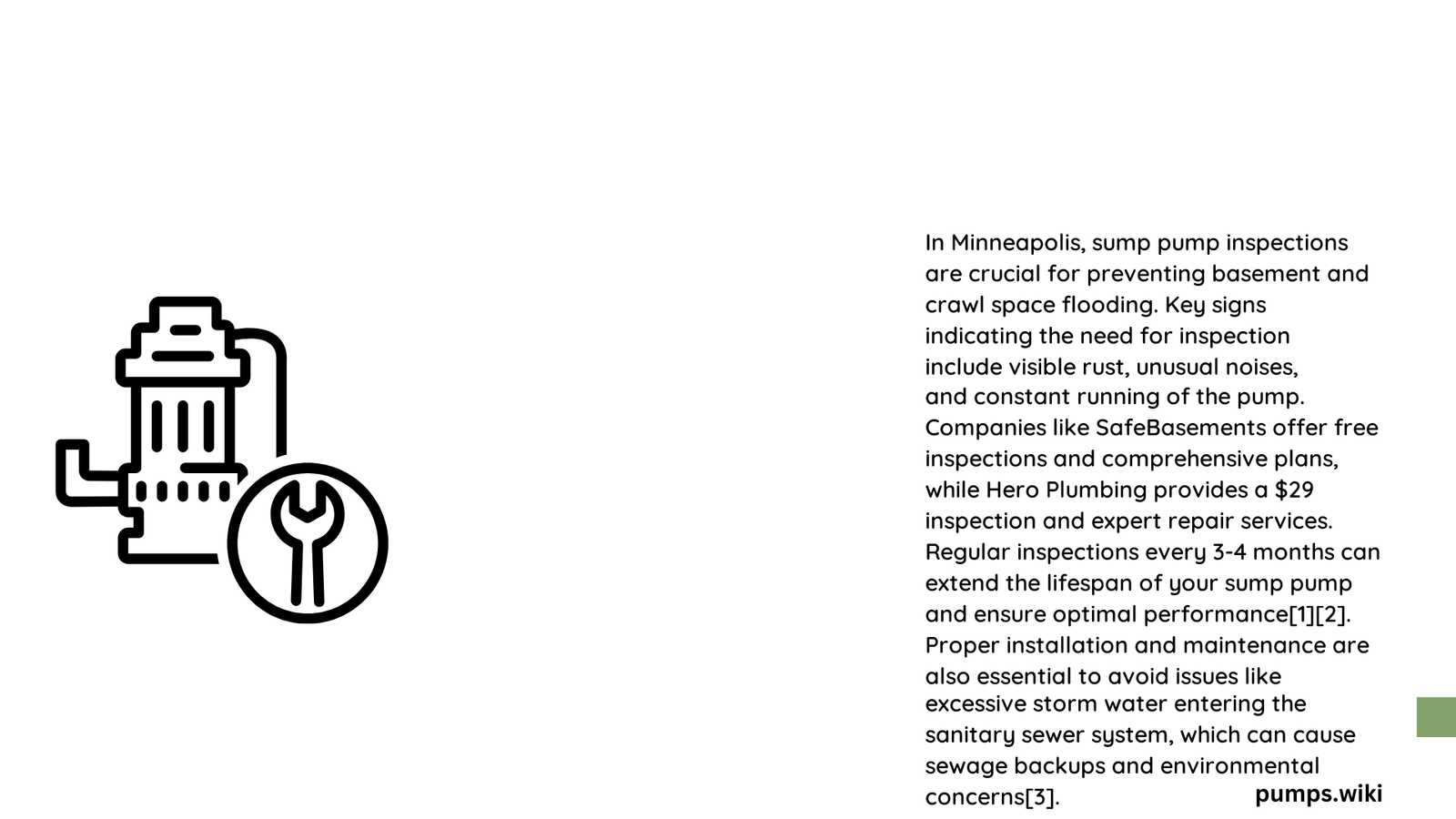Minneapolis homeowners face unique water management challenges that make sump pump inspections critical. With varying seasonal moisture levels and potential basement flooding risks, regular professional and DIY inspections can prevent costly water damage, protect property infrastructure, and ensure reliable drainage systems function optimally during critical moments.\n\n## Why Are Sump Pump Inspections Crucial in Minneapolis?\n\nSump pump inspections represent a proactive approach to home maintenance, especially in Minneapolis’s variable climate. These systematic evaluations help identify potential issues before they escalate into significant problems.\n\n### What Components Require Detailed Examination?\n\n#### Key Inspection Areas\n- Sump Pit Condition\n – Check for debris accumulation\n – Verify unobstructed float switch movement\n – Assess overall pit cleanliness\n\n- Mechanical Components\n – Evaluate impeller functionality\n – Test float switch responsiveness\n – Inspect electrical connections\n\n### How Often Should Minneapolis Homeowners Conduct Inspections?\n\n| Inspection Frequency | Recommended Actions |\n|———————|———————|\n| Monthly | – Clean inlet screen\n- Remove minor debris\n- Quick operational test |\n| Quarterly | – Comprehensive pit cleaning\n- Detailed float switch testing\n- Drainage pipe evaluation |\n| Annually | – Professional comprehensive inspection\n- Battery backup system check\n- Complete system diagnostic |\n\n## What Factors Influence Sump Pump Inspection Costs?\n\nSump pump inspection costs in Minneapolis typically range between $100-$300, depending on several variables:\n\n1. Inspection Complexity\n – Basic visual assessment\n – Detailed mechanical evaluation\n – Advanced diagnostic testing\n\n2. Service Provider Expertise\n – Independent contractors\n – Specialized plumbing companies\n – Municipal-affiliated services\n\n3. Additional Service Requirements\n – Cleaning services\n – Minor repairs\n – Component replacement\n\n## What Are Common Minneapolis-Specific Sump Pump Challenges?\n\nMinneapolis homeowners encounter unique environmental challenges that impact sump pump performance:\n\n- Seasonal temperature fluctuations\n- High groundwater levels\n- Potential freezing conditions\n- Rapid snowmelt periods\n\n### Recommended Preventative Strategies\n\n- Install insulated discharge pipes\n- Implement battery backup systems\n- Use high-capacity pumps\n- Maintain proper drainage slopes\n\n## How Can Homeowners Detect Potential Sump Pump Issues?\n\nEarly detection prevents catastrophic failures. Watch for these warning signs:\n\n- Unusual grinding or rattling sounds\n- Inconsistent water removal\n- Visible rust or corrosion\n- Frequent cycling\n- Unexplained moisture in basement areas\n\n## Local Regulatory Considerations\n\nMinneapolis mandates specific guidelines for sump pump installations:\n\n- Prohibited sanitary sewer system connections\n- Required discharge distance from foundation\n- Mandatory backflow prevention mechanisms\n\n## Professional vs. DIY Inspections\n\nWhile homeowners can perform basic maintenance, professional inspections offer comprehensive evaluations:\n\nDIY Capabilities:\n- Monthly screen cleaning\n- Basic operational testing\n- Visual system assessment\n\nProfessional Services:\n- Advanced diagnostic testing\n- Precision mechanical evaluations\n- Comprehensive system analysis\n- Detailed repair recommendations\n\n## Conclusion\n\nSump pump inspections in Minneapolis represent a critical home maintenance strategy. By understanding local environmental challenges, implementing regular inspections, and working with qualified professionals, homeowners can effectively protect their properties from potential water damage.\n\n### Reference:\n- Wellbrook Plumbing Maintenance Guide\n- A.J. Alberts Sump Pump Care\n- City of Minneapolis Sump Pump Regulations

